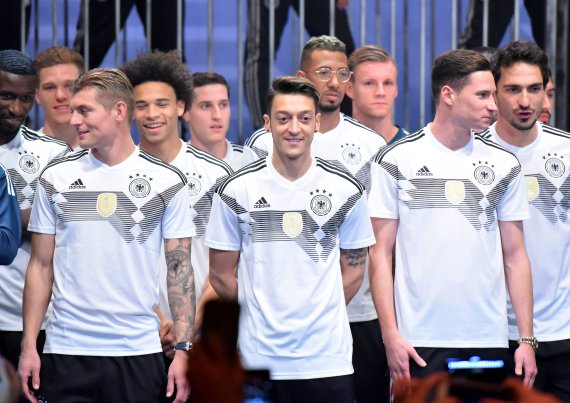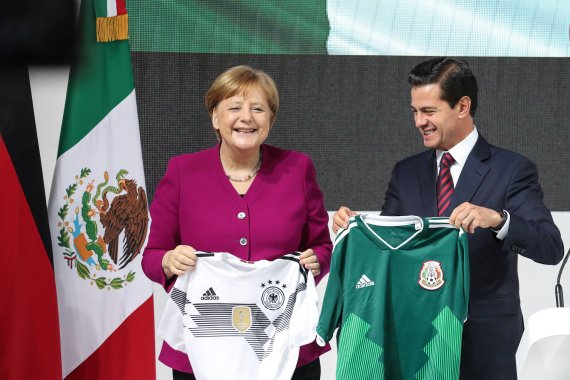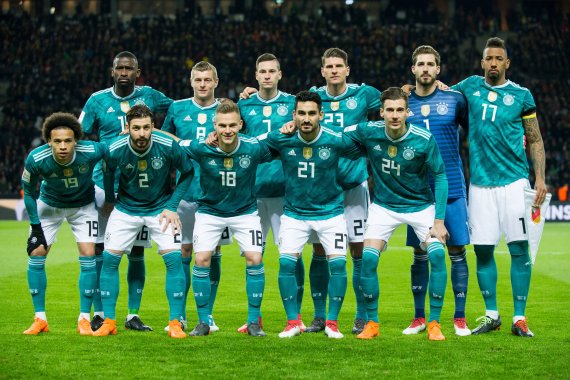
Chancellor Angela Merkel has already received her personal DFB jersey, of course. Almost two months before the start of the World Cup (June 14 to July 15), National Coach Jogi Löw and Team Manager Oliver Bierhoff presented the world’s most famous supporter of the German team with a jersey with her name and the number 4 on the back.
The 4 stands for the number of German World Cup titles, as well as for Merkel’s fourth term in office. Along with Matthias Ginter from Borussia Mönchengladbach, she was the “last” member of the eleven-person team.
The Chancellor received the coveted jersey as a gift. For “normal” customers, the replica jersey costs exactly 89.95 euros, according to Adidas’ recommended retail price. For the authentic jersey with high-tech materials that’s also worn by the stars on the field, available for the first time, as much as 129.95 euros are needed. Roland Auschel said at ISPO Digitze that the sporting goods manufacturer did not like the German end in the group stage in particular. According to the German newspaper "Handelsblatt", Adidas loses 40 million euros after the German elimination. Meanwhile the online shops sell the jerseys far below their original value.
The design of the white-black-grey home jersey with a ring of diamonds is meant to evoke the 1990 World Cup in Italy, when Germany became world champions with Lothar Matthäus as captain. Green, the color of hope, plays the leading role in the away jersey just as it did back then.
Adidas sold over three million German jerseys at the 2014 World Cup in Brazil. In the year of the German World Cup triumph, the sporting goods giant sold jerseys, soccer shoes, balls, and fan merchandise for a record sum of roughly 2.1 billion euros.
Naturally, they aim to top that this year. “We are the clear global market leader in soccer, and will sponsor eleven teams at next year’s World Cup. Overall, I expect a significant increase in Adidas jersey sales in 2018 due to the World Cup. We hope that our teams will get as far as possible - we’re outfitting three of the favorites with Germany, Spain, and Argentina,” Adidas CEO Kasper Rorsted told the “Rheinische Post.”
Since taking office on October 1, 2016, the new CEO has led the brand with the three stripes to more and more new records. Under CEO Kasper Rorsted, share prices have doubled, annual sales exceeded 20 billion euros for the first time in 2017, and profits rose to over two billion euros.
The jersey of world champions Manuel Neuer, Mesut Özil, and company are set to contribute to new records this year – after all, it’s also more expensive than ever before. Since the 2006 World Cup, the price has risen by a whopping 25 euros per replica jersey. This puts more money in the bank, but Adidas also has to spend considerably more money outfitting the German world champions.

Following the extension of the contract until 2022, at least 50 million euros per year will now have to be paid instead of the roughly 25 million euros per year to date; with premiums, the sum can increase again by up to 20 million euros. But these are undoubtedly worthwhile investments, as they ultimately improve revenue from jersey sales as well as the brand’s image.
According to an Interbrand study, Adidas is one of the brands with the strongest growth in 2017. In the global brand ranking, the company from Herzogenaurach has risen from 60th to 55th place. And CEO Kasper Rorsted wants to make the world’s number 2 in the sporting goods industry (after industry leader Nike) even better known and more profitable with the help of the Germany jersey.
“One important driver is our online business, which we are expanding heavily. In 2016, our Internet sales increased by 60 percent to one billion euros. It’s expected to quadruple by 2020. This has resulted in an above-average increase in returns, because we are much more profitable in our online business,” says Rorsted. “We’ve become a digital company,” Kasper Rorsted explained at the balance sheet press conference in March 2018.

This is why, after the presentation in November 2017, Adidas initially only sold the German jersey through their own online shops, Adidas stores, and the DFB. Naturally this irritated retailers, especially the large retailer associations who have thus far brought the lion’s share of the millions of German jerseys to customers.
“Naturally, this measure has an impact on our retailers’ sales opportunities for an item as important as the DFB team jersey,” Intersport CEO Kim Roether told ISPO.com. In contrast to previous World Cup tournaments, this time Intersport did not process orders from its retailers via the central warehouse in Heilbronn – each retailer had to order individually.
Some seething took place behind the scenes – also because the wholesale trade had to place their entire orders for the German World Cup jersey up to and including summer 2018 back in fall of 2017.
Adidas defends itself against the criticism. “Specialty retail is still an important partner for us,” said a spokeswoman. “But digital distribution channels are also becoming increasingly important. We go where our consumers are. They’re buying more and more online, so we want to offer them a special shopping experience there.”
In an interview with ISPO.com, however, Sales Director Roland Auschel made it clear that the online first activation of the German World Cup jersey was definitely controversial, both in retail and internally: “We discussed this with our customers far in advance. e also aren’t saying that we’ll have to do it again next time. But we are convinced that we need to try out new things to see what the consumer wants,” Auschel told ISPO.com.
In addition to the growing competition from private labels, the brand with the stripes is also annoyed that the German jersey is sold well below the recommended retail price in many places. Some shops offer the DFB jersey for as little as 60 euros.
What many people don’t know: The lion’s share of the recommended retail price of 89.95 euros for a jersey – just under 40 euros – will go to retailers. Thus, their profit margin is also the highest.
According to the marketing company PR Marketing, Adidas will remain at around 17 euros per shirt sold, with only 8.60 euros earmarked for production and transport. The DFB collects a 5.50 euro license fee per shirt, and the German government can look forward to 14.36 euros in sales tax. The actual manufacturer and the transporter only pay 8.60 euros per shirt, while the rest are marketing and distribution costs.
- Awards
- Mountain sports
- Bike
- Fitness
- Health
- ISPO Munich
- Running
- Brands
- Sustainability
- Olympia
- OutDoor
- Promotion
- Sports Business
- Textrends
- Triathlon
- Water sports
- Winter sports
- eSports
- SportsTech
- OutDoor by ISPO
- Heroes
- Transformation
- Sport Fashion
- Urban Culture
- Challenges of a CEO
- Trade fairs
- Sports
- Find the Balance
- Product reviews
- Newsletter Exclusive Area
- Magazine







